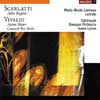Scarlatti, D Salve Regina; Vivaldi Stabat Mater
Glowing performances by a young contralto are the highlights here
View record and artist detailsRecord and Artist Details
Composer or Director: Domenico Scarlatti, Antonio Vivaldi, Charles Avison
Genre:
Vocal
Label: Analekta
Magazine Review Date: 2/2004
Media Format: CD or Download
Media Runtime: 58
Mastering:
Stereo
DDD
Catalogue Number: FL23171

Tracks:
| Composition | Artist Credit |
|---|---|
| Sinfonia for Strings |
Antonio Vivaldi, Composer
Antonio Vivaldi, Composer Jeanne Lamon, Violin Tafelmusik |
| Salve Regina |
Domenico Scarlatti, Composer
Domenico Scarlatti, Composer Jeanne Lamon, Violin Marie-Nicole Lemieux, Contralto (Female alto) Tafelmusik |
| (12) Concerti grossi after D. Scarlatti, Movement: G minor |
Charles Avison, Composer
Charles Avison, Composer Jeanne Lamon, Violin Tafelmusik |
| Stabat Mater |
Antonio Vivaldi, Composer
Antonio Vivaldi, Composer Jeanne Lamon, Violin Marie-Nicole Lemieux, Contralto (Female alto) Tafelmusik |
| Concerto for Strings |
Antonio Vivaldi, Composer
Antonio Vivaldi, Composer Jeanne Lamon, Violin Tafelmusik |
Author: Stanley Sadie
Those two elegiac masterpieces of the Italian late Baroque – Scarlatti’s Salve regina and Vivaldi’s Stabat mater – have been recorded several times before, but chiefly in recent years by countertenors; they were, of course, composed for castrati. Here is a chance to hear them sung by a very fine young contralto. Marie-Nicole Lemieux brings a full and even, well-focused voice to the music, and makes much of the closing pages of the Salve regina, an extraordinarily original piece written in Madrid at the end of his life and apparently his only sacred work composed since he left Italy. The poignant ‘O clemens, O pia’, with its characteristic switches between major and minor, is done in a free and heartfelt style.
The Stabat mater gives ample scope to her rich and smooth lowest register. Here, too, the impassioned passages – for example, the setting of ‘Quis est homo qui non fleret’ – are tellingly sung, with a glow and richness to the middle and upper part of her voice. There is good support from Tafelmusik, as vital as ever.
They bring plenty of energy to the G major Vivaldi concerto, which in truth is one of his emptier pieces, and it needs it; but the A major is a fine piece and has a spirited reading. The Avison arrangement from the sonatas is good fun, with the scurrying music of the second movement done with real brilliance and the finale done with a real orchestral counterpart to the harpsichord brilliance and glitter of the original. But to say that Lemieux is the best thing here is perhaps to state the obvious.
The Stabat mater gives ample scope to her rich and smooth lowest register. Here, too, the impassioned passages – for example, the setting of ‘Quis est homo qui non fleret’ – are tellingly sung, with a glow and richness to the middle and upper part of her voice. There is good support from Tafelmusik, as vital as ever.
They bring plenty of energy to the G major Vivaldi concerto, which in truth is one of his emptier pieces, and it needs it; but the A major is a fine piece and has a spirited reading. The Avison arrangement from the sonatas is good fun, with the scurrying music of the second movement done with real brilliance and the finale done with a real orchestral counterpart to the harpsichord brilliance and glitter of the original. But to say that Lemieux is the best thing here is perhaps to state the obvious.
Discover the world's largest classical music catalogue with Presto Music.

Gramophone Digital Club
- Digital Edition
- Digital Archive
- Reviews Database
- Full website access
From £8.75 / month
Subscribe
Gramophone Full Club
- Print Edition
- Digital Edition
- Digital Archive
- Reviews Database
- Full website access
From £11.00 / month
Subscribe
If you are a library, university or other organisation that would be interested in an institutional subscription to Gramophone please click here for further information.




